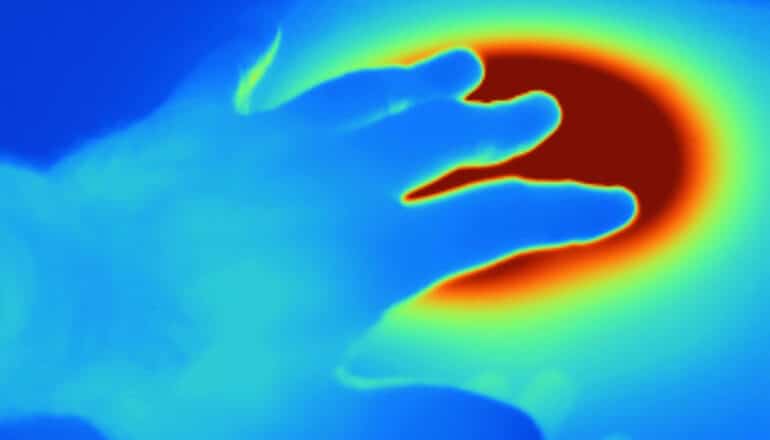
Researchers have identified the pathway in fruit flies that reduces the sensation of pain from heat. Remarkably, just a single neuron on each side of the animal’s brain controls the response.
What’s more, the molecule responsible for suppressing this sensation in adult flies has the opposite role in fly larvae. The surprising results appear in Current Biology.
The brain of a fruit fly has about a million-fold fewer neurons than our own. “Yet we didn’t anticipate that a single pair of neurons would have such an important role in pain suppression,” says senior author Craig Montell, professor of molecular, cellular, and developmental biology at the University of California, Santa Barbara.
“We call them ‘Epione,’ or Epi neurons, for the Greek goddess of soothing pain,” says first author Jiangqu Liu, a postdoctoral fellow in the Montell lab.
Pain from heat, or nociception
The authors are quick to clarify a point. “Pain is an interpretation,” Montell says. “A hardy smack on the back from a teammate after a win might feel great, but not from a bully on the playground. Since we can’t ask fruit flies about their interpretation of hot temperatures, a more accurate term is ‘nociception,’ which refers to how the body senses a potentially harmful stimulus, and then relays the information to induce an avoidance response.”
Humans are well known to be able to suppress pain under some situations. However, scientists don’t know much about suppression of nociception in flies, which are workhorses for sensory research. Montell and his lab wanted to determine if flies have such a system, and if so, locate the neurons involved and understand the mechanism.
The researchers focused on nociception in response to heat. They first needed a way to measure how the animals responded to hot temperatures. They placed flies on a hot plate and measured the number that jumped off within 10 seconds. Nearly all the flies jumped between 38° and 44° Celsius (roughly 100° to 111° Fahrenheit). Now the team set out to see if they could identify neurons that suppress their aversion to high temperatures and reduce the jump response.
Finding the right neurons
The authors wondered whether the neurons involved in suppressing thermal pain might express a particular neuropeptide. Neuropeptides are a bit like neurotransmitters, except that neurotransmitters mediate between adjacent neurons, while neuropeptides can have a more systemic effect. As a result, they affect many behaviors. Different sets of neurons tend to express different neuropeptides. Liu, Montell, and their coauthors used the DNA segments that control the expression of 35 different neuropeptide genes to drive expression of a protein that activates neurons.
Out of the 35 different groups of neurons, one clearly reduced the flies’ tendency to jump from the hot plate. These neurons produce the neuropeptide AstC, which is related to a mammalian compound that contributes to pain suppression in humans.
The researchers then expressed the gene coding for a light-sensitive channel in this group of neurons. This enabled them to activate the neurons using light. As expected, stimulating these neurons reduced the flies’ tendency to jump off the hot plate.
The authors then used the section of DNA that controls expression of AstC to instead control a gene for green fluorescent protein. Now they could finally see which neurons were activating. That’s when they discovered that triggering just a single neuron on each side of the brain (the Epi neurons) suppressed the nociceptive response.
Epi neurons
Once the team found the neurons responsible for suppressing thermal pain, they were curious whether Epi neurons were thermosensitive themselves, or were receiving a signal from some other neurons.
The researchers expressed a gene coding for a protein that would fluoresce when calcium ions flooded into Epi neurons. They found that calcium levels increased as the temperature rose, even when they used a chemical to block communication between neurons. These findings indicated that the Epi neurons were directly sensing the high temperature.
The researchers determined that a specific ion channel in the cell membrane of Epi neurons was responsible for detecting the heat. This channel, called “Painless,” is a member of the TRP family of channels. TRP channels have broad roles in sensation, including temperature sensation. In fact, Painless is also required for thermal nociception in fly larvae. “So Painless can have opposite roles in the response to noxious heat,” Montell says. “In some neurons, the channel is required for the animal to escape from hot temperatures, while in Epi neurons, Painless is needed to suppress nociception. That is an interesting and surprising twist.”
“This is the first time, to my knowledge, that a TRP channel is found to sense noxious heat not to induce a nociceptive response, but to suppress it,” Montell adds.
To recap: the authors found that there is a mechanism to suppress thermal nociception in flies, and they discovered that it is mediated by a single pair of neurons, called Epi neurons. They also found that Epi neurons respond directly to heat, and that this ability depends on a previously known TRP channel called Painless, which can actually trigger nociception in fly larvae. The team also found that heat activates Epi neurons directly, causing them to release the neuropeptide AstC. This compound then binds to the AstC-R1 receptor in other neurons that is related to mammalian opiod receptors.
The team plans to further investigate the pathways involved in this anti-nociception response. For instance, they hope to identify the neurons that function downstream of those that express AstC-R1. Their work raises the question as to whether a thermally-activated TRP channel might suppress nociception in mammals as well. If so, Montell suspects it would be found in our extremities rather than the brain, since mammals maintain a constant internal temperature, unlike fruit flies.
Source: UC Santa Barbara
The post Fruit fly channel for pain can also suppress it appeared first on Futurity.
from Futurity https://ift.tt/lSuj5NA
No comments:
Post a Comment